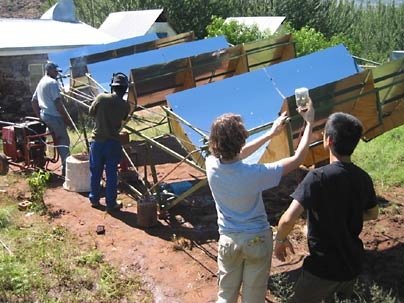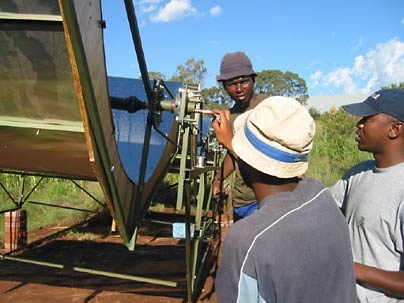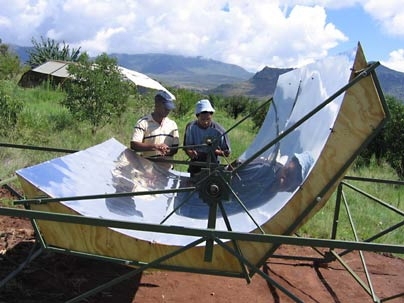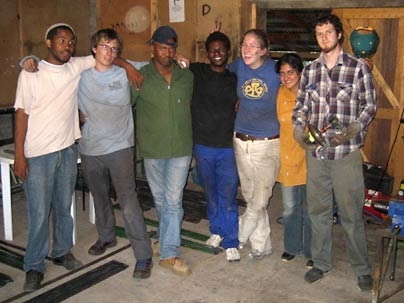Two MIT graduate students in civil and environmental engineering have won a 2006 World Bank Development Marketplace grant to develop a solar micro-generator that would provide affordable energy to Lesotho, a mountainous African country where just 10 percent of the population has electricity and almost 30 percent of adults are living with HIV/AIDS.
The students, Matthew Orosz and Amy Mueller, received just over $100,000 for their project, one of 30 the World Bank funded this year in the competitive Development Marketplace (DM) grant program. More than 2,500 teams sought DM funding for projects on this year's theme, "Innovations in Water, Sanitation and Energy Services for Poor People."
The pioneering MIT technology combines solar thermal power with a microscale generator that is built and repaired with ordinary auto parts. The MIT team's goal is to provide not only energy but also support for the local economy through manufacturing the generator in Lesotho, a nation about the size of Maryland.
A hot idea
Orosz, a former Peace Corps volunteer in Lesotho, was inspired to build the first iteration of the MIT generator when he observed a massive parabolic trough that "perfectly baked" 10 loaves of bread at a time for one community there.
He burned his hand on the trough, built by the Bethel Business and Community Development Center (BBCDC), now the team's partner in Lesotho, and "figured the heat was high grade enough to try mechanical conversion," he said.
As Orosz explained it, the system, known as an organic Rankine cycle (ORC), works by concentrating solar thermal energy to heat a fluid refrigerant to boiling. The typical ORC is a massive affair, but in the MIT micro-version, the system's vapor is expanded through a rotary vane turbine (a car power-steering pump) that makes mechanical energy to spin a generator (a car alternator).
Concentration of the solar energy is achieved via an array of parabolic mirrors that electromechanically track the sun daily and focus its energy on an absorber tube that exchanges heat with the ORC, he said.
The latest prototype of the MIT system, built in Lesotho in January, is "sized to produce about 1 kilowatt of electricity, with about 10 kilowatts of heat recovered as hot water," Orosz said.
In Western terms, those are micro-amounts, sufficient to cover only a fraction of the energy consumed in a typical U.S. home. But in Lesotho, a kilowatt of electricity and additional hot water could transform lives now marooned by poverty, team members said.
Bringing affordable electricity and hot water into communities in Lesotho could "save women time they normally spend collecting fuel so they can heat water to take a bath, or power a TV so a village can watch their favorite soccer match. It could enable students to study at night in a lit school, or enable a seamstress to set up a local business with a couple of sewing machines," Orosz said.
Local partners
The micro-generator team -- known as the Solar Turbine Group -- has already worked in Lesotho with BBCDC and local engineering students. Mueller, who joined the team this year, went to Lesotho in January with Orosz and team member Perry Hung, a sophomore in electrical engineering and computer science. Mueller and Orosz will return there for nine months in September, with team member Elizabeth Wayman (S.M. '06).
The World Bank grant will support their trip and the work of taking the project from prototype to functioning generator for a Lesotho school or clinic. The project will include the training of Lesotho residents in how to operate and repair the generator.
Mueller's first trip to Lesotho's barren mountains convinced her that the MIT project is about "so much more than technology. As engineers, we're all excited about making things work. Once I was on the ground, the social and economic components were really brought home: All of the trees have been cut down and burned to heat water or cook food. People are in desperate need of an energy source other than brushwood," she said.
Yet technology does play a crucial role, according to Mueller. She believes it is useful to learn high-tech methods, then "scale back and find a simpler, less expensive way to tackle the same problems. It is also important to realize there are still places where one person can make a difference," she said.
MIT support
For Orosz and Mueller, one person has already made a difference in their lives and the life of their energy innovation. Their advisor, Harold Hemond, the William E. Leonhard Professor of Civil and Environmental Engineering, provided "insightful suggestions along the way and trusted us to strike the right balance between our graduate research and our commitment to making this project a reality," Orosz said.
Initially incubated in MIT's D-Lab class taught by Amy Smith, an instructor in the Edgerton Center, the MIT solar micro-generator won numerous awards before receiving the World Bank grant. The team (then known as Parabolic Power) won two consecutive MIT IDEAS competitions, and MIT's Public Service Center has twice funded team members' work in Lesotho.
In 2006, Orosz received a Carol Wilson Award to advance the project and team members Sorin Grama, a graduate student in system design and management, and MIT affiliate Ignacio Aguirrer represented the team at the Massachusetts Ignite Clean Energy Competition, winning a third prize.
A version of this article appeared in MIT Tech Talk on June 7, 2006 (download PDF).









